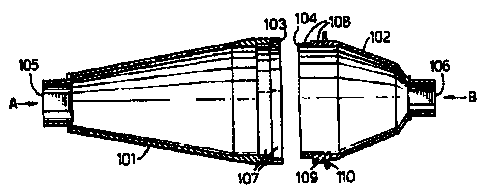Some of the information on this Web page has been provided by external sources. The Government of Canada is not responsible for the accuracy, reliability or currency of the information supplied by external sources. Users wishing to rely upon this information should consult directly with the source of the information. Content provided by external sources is not subject to official languages, privacy and accessibility requirements.
Any discrepancies in the text and image of the Claims and Abstract are due to differing posting times. Text of the Claims and Abstract are posted:
| (12) Patent: | (11) CA 2354561 |
|---|---|
| (54) English Title: | SPACER DEVICE FOR INHALER |
| (54) French Title: | DISPOSITIF D'ECARTEMENT POUR INHALATEUR |
| Status: | Expired and beyond the Period of Reversal |
| (51) International Patent Classification (IPC): |
|
|---|---|
| (72) Inventors : |
|
| (73) Owners : |
|
| (71) Applicants : |
|
| (74) Agent: | MARKS & CLERK |
| (74) Associate agent: | |
| (45) Issued: | 2008-01-08 |
| (86) PCT Filing Date: | 1999-03-18 |
| (87) Open to Public Inspection: | 2000-06-15 |
| Examination requested: | 2004-03-11 |
| Availability of licence: | N/A |
| Dedicated to the Public: | N/A |
| (25) Language of filing: | English |
| Patent Cooperation Treaty (PCT): | Yes |
|---|---|
| (86) PCT Filing Number: | PCT/GB1999/000834 |
| (87) International Publication Number: | WO 2000033902 |
| (85) National Entry: | 2001-06-11 |
| (30) Application Priority Data: | ||||||
|---|---|---|---|---|---|---|
|
A spacer device for an inhaler is made of a non-metallic antistatic material,
preferably polyamide. The device may comprise two
frustoconical members (101, 102) joined at their wider ends (103, 104), with
an inlet (105) and outlet (106) at respectively, the two narrower
ends. A measured dose of medicament is injected through the inlet (103), and
then inhaled from the chamber through the outlet (106).
L'invention concerne un dispositif d'écartement pour inhalateur, fabriqué dans une matière antistatique non métallique, de préférence un polyamide. Le dispositif peut comprendre deux éléments tronconiques (101, 102) assemblés au niveau de leur extrémité (103, 104) la plus large, leurs extrémités les plus étroites comportant respectivement une entrée (105) et une sortie (106). Une dose de médicament est injectée par l'entrée (105), puis inhalée hors de la chambre par la sortie (106).
Note: Claims are shown in the official language in which they were submitted.
Note: Descriptions are shown in the official language in which they were submitted.

2024-08-01:As part of the Next Generation Patents (NGP) transition, the Canadian Patents Database (CPD) now contains a more detailed Event History, which replicates the Event Log of our new back-office solution.
Please note that "Inactive:" events refers to events no longer in use in our new back-office solution.
For a clearer understanding of the status of the application/patent presented on this page, the site Disclaimer , as well as the definitions for Patent , Event History , Maintenance Fee and Payment History should be consulted.
| Description | Date |
|---|---|
| Time Limit for Reversal Expired | 2018-03-19 |
| Letter Sent | 2017-03-20 |
| Inactive: Office letter | 2014-07-28 |
| Inactive: Correspondence - Transfer | 2014-07-17 |
| Grant by Issuance | 2008-01-08 |
| Inactive: Cover page published | 2008-01-07 |
| Pre-grant | 2007-10-11 |
| Inactive: Final fee received | 2007-10-11 |
| Notice of Allowance is Issued | 2007-06-27 |
| Letter Sent | 2007-06-27 |
| Notice of Allowance is Issued | 2007-06-27 |
| Inactive: Approved for allowance (AFA) | 2007-05-16 |
| Amendment Received - Voluntary Amendment | 2007-02-21 |
| Inactive: S.30(2) Rules - Examiner requisition | 2006-08-24 |
| Amendment Received - Voluntary Amendment | 2004-08-16 |
| Letter Sent | 2004-03-22 |
| Request for Examination Requirements Determined Compliant | 2004-03-11 |
| All Requirements for Examination Determined Compliant | 2004-03-11 |
| Request for Examination Received | 2004-03-11 |
| Letter Sent | 2001-10-23 |
| Inactive: Cover page published | 2001-10-19 |
| Inactive: First IPC assigned | 2001-09-20 |
| Inactive: Single transfer | 2001-09-13 |
| Inactive: Courtesy letter - Evidence | 2001-09-04 |
| Inactive: Notice - National entry - No RFE | 2001-08-28 |
| Application Received - PCT | 2001-08-27 |
| Application Published (Open to Public Inspection) | 2000-06-15 |
There is no abandonment history.
The last payment was received on 2007-03-01
Note : If the full payment has not been received on or before the date indicated, a further fee may be required which may be one of the following
Please refer to the CIPO Patent Fees web page to see all current fee amounts.
Note: Records showing the ownership history in alphabetical order.
| Current Owners on Record |
|---|
| CIPLA LIMITED |
| Past Owners on Record |
|---|
| AMAR LULLA |
| XERXES RAO |